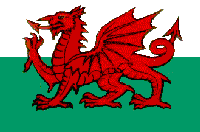 Welsh Castle Summaries
Welsh Castle Summaries Welsh Castle Summaries
Welsh Castle Summaries
![[Carreg Cennan]](cennan.gif)
 tag; click them to enlarge.]
tag; click them to enlarge.]

WALES |
Wales was always a very turbulent land, and is full of ancient Celtic hill forts, but the invaders introduced the idea of castles. The castles of Wales fall into three categories: (1) The Norman Conquest fortresses and manorial estates (Chepstow, Pembroke, Manorbier, Tretower), (2) the Edwardian power bases (Caernarvon, Conwy, Harlech), and (3) the native Welsh refuges (Dolwyddelan, Ewloe, Castell-y-Bere). It's not really that simple, because the sizes and complexities vary so much in these categories, but that will do for this web page. Wales has one of the best concentrations of castles in Europe. |
![[Beaumaris Castle]](beaumar.jpg) Edward's moated beauty (every one of his famous
castles has something different going for it, in spite of a common
thread of advanced fortification technology); this is in a flat area on the southeast
coast of the island of Anglesey (near the place where the Romans
slaughtered the last great conclave of Druids, vividly described by Tacitus).
Edward's moated beauty (every one of his famous
castles has something different going for it, in spite of a common
thread of advanced fortification technology); this is in a flat area on the southeast
coast of the island of Anglesey (near the place where the Romans
slaughtered the last great conclave of Druids, vividly described by Tacitus).

![[Carreg Cennan]](carreg.jpg) Superb castle on a high crag in the middle
of an extremely rural part of Wales; at one point it was the hang-out
of a gang of bandits who terrorized the region; has a nifty cave under
it that can be reached via a 'secret' passage.
Superb castle on a high crag in the middle
of an extremely rural part of Wales; at one point it was the hang-out
of a gang of bandits who terrorized the region; has a nifty cave under
it that can be reached via a 'secret' passage.
 [* Why didn't I spell it Conway, as most people used-to-be-used-to? See footnote.]
[* Why didn't I spell it Conway, as most people used-to-be-used-to? See footnote.]
![[Dolwyddelan Castle]](dolwd.gif) Like other 'native' castles, this is nice and
small and remote; beautiful setting in Snowdonia; smallish square keep
and not much else (except when we went there, the most devastating gale
in recent history was blowing and we had to form a human chain of hand
links to rescue some children who were literally being blown off the exposed
staircase to the keep).
Like other 'native' castles, this is nice and
small and remote; beautiful setting in Snowdonia; smallish square keep
and not much else (except when we went there, the most devastating gale
in recent history was blowing and we had to form a human chain of hand
links to rescue some children who were literally being blown off the exposed
staircase to the keep).
![[Manorbier]](manorb.jpg) the medieval monk/historian Geraldis Cambrensis was born here; nicely located
in a remote cove with a good beach and great rock formations.
the medieval monk/historian Geraldis Cambrensis was born here; nicely located
in a remote cove with a good beach and great rock formations.
[These are on my want-to-see list. If you have other recommendations or comments, please let me know. Write to: Grobius]
Castell Nant-y-Gof Bwlch -- an imaginary Welsh Castle: Gwernogle Castle |
There are a LOT of Welsh castles I've only seen from the outside (Cilgerran and White Castle, for example, and I couldn't photograph Conway because I was out of film and couldn't buy any), and that's because I was there on a Sunday, or during one of their peculiar 'lunch' breaks, or whatever. Don't forget, though, that this is another country, and not England, in spite of centuries of oppression against the Celtic races and attempts to Anglicize the people. Gripe against the Welsh Sabbath but show respect! Tell whoever gives you the cold shoulder your last name is James or Price or something else Welsh and you will get a different reception -- actually, you can be a Stanislaus, but don't ever say your name is Edward. The only places open in Wales on a Sunday are Indian restaurants. (Well, Cardiff might be an exception.) [Digression: have you ever noticed that an Indian accent is very similar to a Welsh accent? Just a cultural coincidence, because the Welsh would never have developed something like Vindaloo curry.]
![[Animation]](dolbeau.gif)
Beaumaris / Dolwyddelan



 Links2Go Britain |